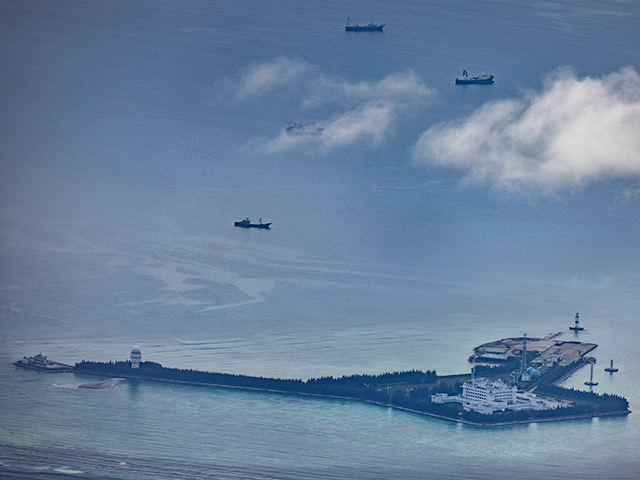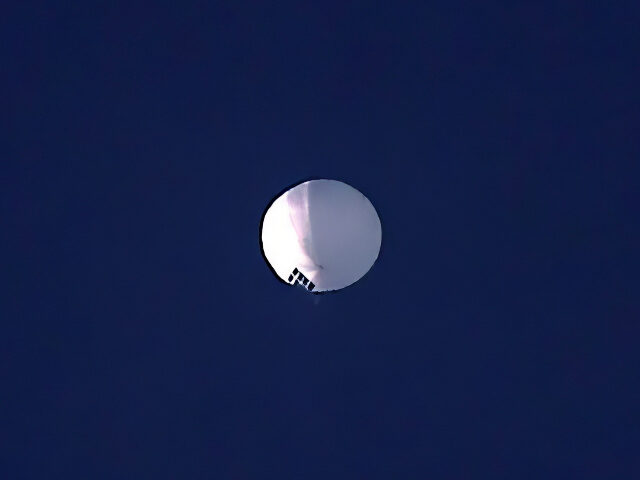After initially denying any knowledge of the huge spy balloon floating over Montana, the Chinese government on Friday claimed it was a “civilian” aircraft intended for “meteorological research” that was blown off course into American airspace.
China has a long history of claiming its provocative military moves are merely research projects, particularly for meteorology.
China’s favorite tactic for pressing its illegal claims across the South China Sea is to drive away ships from competing powers like the Philippines, often using huge swarms of paramilitary “fishing boats” that carry as many rifles as they do fishing poles, and then artificially enhance the size of tiny islets until they are large enough to support military bases.
When the Chinese are called out for militarizing islands in disputed waters, they usually respond by claiming they are innocently conducting “marine meteorological monitoring, warning, forecasting, prediction, and scientific research.”
In 2015, during the early stage of its militarization projects in the disputed Spratly and Paracel Islands, China claimed it just wanted “meteorological facilities” in the islands so it could helpfully provide better weather reports for the South China Sea region.
Chinese dictator Xi Jinping made a public promise in September 2015 that China would not “pursue militarization” of the artificial islands it was developing, even as satellite photos revealed military-grade airstrips and military barracks appearing on the artificially-enhanced reefs.

Buildings and structures are seen on the artificial island built by China in Gaven Reefs on October 25, 2022 in Spratly Islands, South China Sea. China has progressively asserted its claim of ownership over disputed islands in the South China Sea by artificially increasing the size of islands, creating new islands and building ports, military outposts and airstrips. The South China sea is an important trade route and is of significant interest as geopolitical tensions remain high in the region. (Photo by Ezra Acayan/Getty Images)
In 2020, China inaugurated two “research stations” at the Fiery Cross and Subi Reefs, which were ostensibly intended to monitor conservation projects, reef ecology, geological disasters, pollution, and freshwater conservation.
The reefs are also claimed by Vietnam, the Philippines, and Taiwan, but China increased their size and then completely covered them with buildings – an impressive engineering feat completed while the entire world grappled with the Wuhan coronavirus.
Critics noted the huge and hasty construction project would have inflicted considerable ecological damage on the reefs, which was not easily squared with China’s insistence that it built those structures to monitor the local ecology.
The Philippines lodged a formal diplomatic protest with China over the Fiery Cross Reef development project, quoting Xi’s broken promise that Beijing would not militarize the islands. Philippine officials noted Fiery Cross Reef was now militarized enough to threaten nearby oil and gas drilling interests.
In March 2022, U.S. Indo-Pacific commander Adm. John C. Aquilino said that China has fully militarized three of the artificial islands it built in disputed waters – including Fiery Cross Reef and Subi Reef.
Aquilino said the islands are now bristling with “missile arsenals, aircraft hangars, radar systems, and other military facilities,” none of which are normally involved in meteorological research.
Aquilino called it the “largest military buildup since World War II.”
“The function of those islands is to expand the offensive capability of the PRC [People’s Republic of China] beyond their continental shores. They can fly fighters, bombers plus all those offensive capabilities of missile systems,” he said.
In May 2020, commercial satellite photos revealed Chinese military helicopters and surveillance aircraft landing on Fiery Cross Reef. The hangars at the airport were now large enough to hold jet fighters and bombers. An amphibious transport ship was docked at the artificially enhanced island’s harbor, which is deep enough to accommodate warships.
China also likes to send “research vessels” on provocative cruises into waters claimed by other nations. In the summer of 2022, a large Chinese “research vessel” called the Yuan Wang was accused of spying by both the U.S. and Indian governments. India’s complaints were serious enough to delay the Yuan Wang’s planned docking in Sri Lanka by a week, and the ship was only allowed to dock after promising not to conduct any “research” in Sri Lankan waters.
Another dubious Chinese “research vessel” is the Zhu Hai Yun, a 292-foot ship built with the intention of conducting “marine science” in the South China Sea. Skeptics say the ship can map the regional seafloor to give an advantage to Chinese submarines, while it carries a swarm of A.I.-controlled drones that would give it troubling surface and air surveillance capabilities.

COMMENTS
Please let us know if you're having issues with commenting.